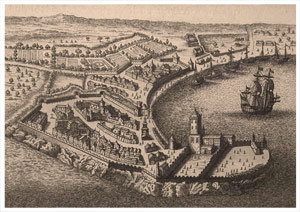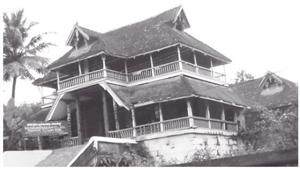The Dutch seized the fort of Cannannore.
Trade agreement with kings inclusive of Ali Raja in north Kerala.

1664
The Kings Bowing Before the Dutch Power
With the kingdom Cochin falling in to its hands, the power and prowess of the Dutch enhanced. Even the native kings who were in trade agreement with the English East India Company too had second thoughts. The native feudatory princes of Purakkad, Paravur, Alangadi and Edappally signed trade agreement with the Dutch accepting their suzerainty. The Dutch captured from the Portuguese the fort of Anjalose at Cannannore in February 1663 and then signed trade agreement with Kolathiri.

In 1664, the year in which the Dutch entered into trade agreement with Ali Raja which helped them to expand their trade in pepper and cardamon, they had the monopoly over pepper trade in Cannanore. The Dutch were thus able to establish the trade monopoly in north Kerala in no time.
It was James Hustaert who had been charged by the Company with the responsibility of making efficient trade links with the native rulers. He had been the chief councillor in India and Ceylon. In accordance with his suggestions, Nieuhoff was appointed to meet and enter into trade agreement with kings of south Kerala. Accordingly he came over the shores of Kayamkulam on 21 January in 1664 along with a translator and some navigators in a small ship.
As the meeting with the king of Kayamkulam was successful, the Dutch group started their voyage towards Purakkad after having been given instructions to make trade agreements. The headquarters of Purakkad feudatory principality, now under the rule of Chempakassery clan, was at Ambalappuzha. Once a staunch ally of the Portuguese, the King of Purakkad agreed to accept the suzerainty of the Dutch. With the suggestions of the ruler of Purakkad, Nieuhoff reached Cochin and brought them to the attention of Hustaert and then returned to Purakkad with new suggestions. They conversed in Portuguese language.The 30-year-old king wore ornaments on his hands and ears studded with diamonds and gems. Nieuhoff recorded that there was no theft on his land since the administration of justice was strict. Purakkad had about 500 warships. It was a kingdom which produced pepper aplenty. Nieuhoff gave assurance to the king that pepper would be weighed down at Purakkad itself and then purchased, as against the practice that had been followed hitherto where the pepper gathered was taken aboard and taken to Cochin and then weighing it down.

Nieuhoff and his group then reached at Karunagappally. The place here named 'Maruthurkulagara' was pronounced by the westerners as Martha or Martan. Residing in a building constructed in the architectural mode of Kerala, the Dutch group sent a message to the feudatory prince. On the following day itself, the group got the message from the native ruler in return inviting them to the palace. At the palace they saw the prince with Muhammadeans casting doubt on them that they were in contact with Muslim traders of Cannannore. The conditions as put forward by the Dutch group during talks such as allowing them to collect pepper, bark of cinnamon and a ban on import of opium were opposed by the Muslim traders. After prolonged talks, the feudatory prince then agreed to give monopoly of pepper trade to the Dutch. Later the Chief Lord under the feudatory prince gave a reception in honour of the visitors where chicken dishes, payasam, sweetened fruits and pastry were supplied. Coming to know that trade agreement was signed with the prince of Purakkad the prince of Kayamkulam gave away to Nieuhoff a present, filigree-sewn cloak through a special messenger. Then he moved to Kollam. Since the rulers with whom the trade agreements to be signed were Queen of Quilon, the Queen of Attingal, the Queen of Kottarakkara and the King of Travancore*.
During this period there broke out war between the Dutch, and the English in Europe. The war was caused by the seizure of possessions of the Dutch in West Indies, South Africa and the America by the British (1665-67). The Dutch navy defeated the English several times .The war ended as a result of the peace treaty signed by the two powers later.
Source: Dr.T.I Ponnan- Dutch Hegemony in Malabar and its Collapse - University of Kerala Publication.
The journey of Nieuhoff by rivers.
Royal procession of the Queen of Attingal escorted by about 700 guards.
It was the queendoms and the reigning queenlets that amazed Nieuhoff in the south Kerala. During that period, like kings, the queens also reigned over cleverly and effectively. It was with them that he had to enter in to trade agreements. From Quilon (Kollam) he proceeded to the Attingal queendom by ship to meet the queen. But after reaching at a place called Kappil he disembarked, and then voyaged on a rural rowing boat through the river Vamanapuram and after a three-hour journey set foot at the palace of Attingal where there had accidently been the king of the principality, Travancore.

The king was readying himself to leave for his palace at Kalkulam (later the palace of Padmanabhapuram). He expressed his desire to meet the king. Nieuhoff and his group were accommodated in a house on the garden on the slope of a hill by the western side of the palace. On the following day, the Dutch group and the representatives of the king had the meeting and Nieuhoff was given a blanket to sit on. During the discussion, where the issue of the expelled king Gotha Varma cropped up, the steward of the king expressed his displeasure at the palace of the Queen of Quilon being set afire. The discussion did not proceed on account of the insistence of Nieuhoff to have a person to person discussion with the king and of the reply communicated by the king through his emissaries to this demand that he had to consult many prior to such a personal meeting. The secret message, in the meanwhile sent to by the Queen of Attingal that she was quite ready to have discussion with the Dutch group, once the king left the palace was not accepted by the Dutch.
The queendoms Desinganadu (Quilon), Kottarakkara (later Elayidathu Swaroopam) and the kingdom Thrippappur (Venad-Travancore) were the matriarchial branches of Attingal dynasty. The eldest Lady of the royal family was the Queen of Attingal too. It was a place where pepper grew in profusion and from neighbouring places too pepper was brought here. Nieuhoff then returned to Kappil and from there embarked to Thengapatm. Later he returned to Quilon.To meet the Queen of Kottarakkara he went to Kiliyalloor (this place, lying on the boundary between Desinganadu and Kottarakkara, was a weaving centre) when it was informed that the Queen had gone to Perakathu. At Quilon itelf the representatives of the king of Travancore (Venad) went to meet Nieuhoff. A trade pact was made on the items, share of the customs revenue, the import of opium and the export of pepper. Included in the pact were the stipulations that nobody other than the Dutch East India Company was entitled to sell or exchange the opium and that nobody other than the Company was entitled to export the bark of cinnamon and pepper.

Nieuhoff held discussions with the Queen of Desinganadu at the Kallada palace. It was the Dutch who destroyed the palace of the queen at Quilon and after that the queen shifted herself to the palace of Kallada which was situated at the banks of the river Kallada. Queen invited the Dutch group inside the palace and she met the foreign dignitaries escorted by about 700 native guards. She had a dress consisting only of a cloth that wound around her waist and of a little piece placed over her shoulders. She wore on her hands and her neck precious gems and diamonds. Brown in colour and middle-aged, she combed back her long hair. Aristocracy was visible in her face. After a prolonged talk she discussed on the trade treaty and accepted all the conditions in the draft for the same. She assured that she would be friendly with the Company. As a mark of respect she pulled out a bangle from her hands and gave it to Nieuhoff who then introduced her to James Cher de Venne, his successor at Quilon consequent on his transfer to Tuticorin requesting that the new incumbent be extended all the help in his new assignment. She then pulled out another bangle from her hand gave off it to the latter. After signing over the trade treaty with the queen reaching at her palace, Nieuhoff, arriving at Quilon, embarked on the ship in1666 aiming to the new destination. During this period there took place the invasion of Shivaji at Decan and it scared off both the Dutch and the English.